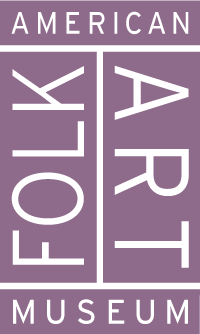Dear members and friends,
Once again it is my pleasure to share exciting news from the American Folk Art Museum.
A Shared Legacy: Folk Art in America drew to a close with a bang—and a bash! The Legacy Bash featured costumed performers, food and drink of the mid-nineteenth century, and an evening of enriching entertainment, surrounded by portraits, carvings, and other works that evoked America during that era. Click here to take a step back in time and relive the evening.
The spring exhibition opens on March 26. When the Curtain Never Comes Down is a novel and compelling presentation of the actions, rituals, practices and enactments of twenty-seven artists from around the world, working from the late 1800s to the present day. The creative or expressive act—the making of a work of art—is as essential to the lives of many of these artists as breathing or eating, and Dr. Valérie Rousseau, Curator, Self-Taught Art and Art Brut, sheds light on the processes they employ as each manifests his or her vision. Said another way, how the artist brings the object into being is as important as the work of art itself. And even more simply: the exhibition explores performance in art by the self-taught.
Marie Lieb, for example, whose work is only documented in two surviving photographs that will be on view, lived in a psychiatric hospital in Germany in the late nineteenth century. She laid strips of cloth across the floor of a common room in a visually dynamic and ephemeral installation, one that changed each time the strips were removed and each time she rearranged them. Bill Anhang, a former engineer living in Montreal, Canada, constructs metal pieces that resemble armor, which he perforates and fits with light-emitting diodes (programmed with microprocessors): his artworks are constantly changing, moving sculptures.
More than 275 works will be on view in this fascinating exhibition, including paintings, sculpture, constructions, sound recordings, video, film, photographs, handmade and knitted clothing and costumes, and many other surprising and thought-provoking forms.
When the Curtain Never Comes Down would not have been possible had it not been for those willing to take risks and fund daring and ambitious projects. I send a special thank you to the National Endowment for the Arts: Art Works and the Coby Foundation, Ltd., for their enthusiasm and support.
On an adventurous note of a different kind, the Museum kicked off a new, international travel program with a well-timed trip to one of the world’s most complex and fascinating destinations: Cuba. Eighteen Museum friends met with local artists at their studios; stopped in at museums; and studied the old-world architectural legacy of this island nation. The excursion took place during the last week of February and first week of March. Those of you who might be interested in sharing just a bit of the warmth these travelers experienced, please view photographs here. I am happy to announce that more international journeys are in the Museum’s planning and we will keep you well informed.
Closer to home, the Museum’s Teen Docent Program hit a high note this past February. Students participating in this program researched and designed interactive tours of A Shared Legacy: Folk Art in America, then hosted forty teens working with the Rubin Museum of Art and the Studio Museum in Harlem, as well as interns with Cooper Union and Hunter College. Topics for discussion were derived from the works of art on view in the exhibition, including gender roles in nineteenth-century America and the history of advertising. Impromptu spoken-word dialogue also took place. Commented Rachel Rosen, the Museum’s Director of Education, “This was a most interesting experience: the works of art on view in A Shared Legacy were created in the nineteenth century, but it was wonderful to observe how the students resonated with people of all ages, especially young adults.” Photographs of this dynamic program can be viewed here.
Self-Taught Genius: Treasures from the American Folk Art Museum was a hit at the Figge Museum in Davenport, Iowa, and its next stop is the Mingei International Museum in San Diego, where it will be on view from April 18 to August 16. Chief Curator Stacy C. Hollander traveled to San Francisco to provide a first-ever presentation to the American Decorative Arts Forum of Northern California, and let me give a shout-out to all our friends on the West Coast.
The Museum’s recently-launched, brand new website will be featured in Communication Arts magazine—a prestigious publication dedicated to design—in their May/June issue. We will share this accolade with you when it appears in print.
What is on the horizon? The Fall Benefit Gala is foremost on our minds and planning has begun. I will have more to report on this in upcoming announcements.
Sincerely,
Dr. Anne-Imelda Radice
Executive Director
Image: Photograph by Malcom Gibson, Bill Anhang (b. 1931) with Scepter and Smart Dumbbell (cast aluminum, light-emitting diodes, electrical wiring, and microprocessors) (detail), Montreal, Canada, n.d., digital photograph. Courtesy Bill Anhang.
